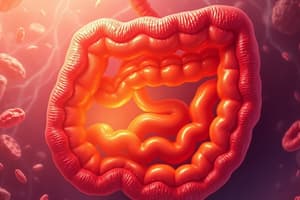Podcast
Questions and Answers
What are simple sugars?
What are simple sugars?
- Complex carbohydrates
- Only glucose and fructose
- Monosaccharides and disaccharides like glucose, fructose, sucrose, and lactose (correct)
- Only disaccharides
What are complex carbohydrates?
What are complex carbohydrates?
Starch and fiber.
What is starch?
What is starch?
The major form of stored carbohydrate in plant cells, found as a mixture of amylose and amylopectin.
What is cellulose?
What is cellulose?
How is dietary starch digested?
How is dietary starch digested?
How is starch digested in the stomach?
How is starch digested in the stomach?
Where does the majority of carbohydrate digestion occur?
Where does the majority of carbohydrate digestion occur?
Carbohydrate digestion in the small intestine first requires pancreatic amylase enzyme, then ______ enzymes.
Carbohydrate digestion in the small intestine first requires pancreatic amylase enzyme, then ______ enzymes.
Match the following disaccharidase enzymes with their function:
Match the following disaccharidase enzymes with their function:
Where are disaccharidase enzymes most active?
Where are disaccharidase enzymes most active?
What is primary lactase deficiency?
What is primary lactase deficiency?
What is lactose intolerance?
What is lactose intolerance?
How are monosaccharides absorbed by intestinal epithelial cells?
How are monosaccharides absorbed by intestinal epithelial cells?
How are carbohydrates digested in the large intestine?
How are carbohydrates digested in the large intestine?
What are the two types of glucose transporters?
What are the two types of glucose transporters?
Describe SGLT glucose transport.
Describe SGLT glucose transport.
What is GLUT glucose transport?
What is GLUT glucose transport?
What is GLUT 1 responsible for?
What is GLUT 1 responsible for?
Flashcards are hidden until you start studying
Study Notes
Simple Sugars
- Comprise monosaccharides and disaccharides like glucose, fructose, sucrose, and lactose.
- Absorbed rapidly and require minimal digestion, leading to quick increases in blood sugar levels.
Complex Carbohydrates
- Include starch and fiber; starch is easier to digest compared to non-starch polysaccharides like dietary fiber.
- Non-starch polysaccharides, such as cellulose, pass through the gastrointestinal tract without being digested and lack nutritive value.
Starch
- Major stored carbohydrate in plant cells, found in the cytosol as amylose and amylopectin.
- Common dietary sources include flour, rice, pasta, and potatoes, which are significant caloric sources for humans.
Cellulose
- Composed of beta-1,4 glycosidic bonds; a principal polysaccharide in plants making up dietary fiber.
- Humans cannot digest cellulose due to the lack of the enzyme "beta-1,4 glycosidase," increasing stool bulk.
Starch Digestion
- Initiated by salivary and pancreatic amylase enzymes.
Amylase Enzyme & Glycemic Index
- Salivary and pancreatic amylase enzymatically break down dietary starches.
- Amylase acts differently on amylose and amylopectin:
- Amylose (found in brown rice, whole grains) is digested slowly, resulting in a low glycemic index.
- Amylopectin (found in white bread, white rice, pasta) is digested quickly, resulting in a high glycemic index, which can raise glucose and insulin levels.
- A diet high in amylopectin starches is associated with an increased risk of type II diabetes.
Stomach Starch Digestion
- Minimal starch digestion occurs in the stomach due to the inactivation of salivary amylase in acidic environments.
- Starch can delay gastric emptying.
Carbohydrate Digestion Location
- The majority of carbohydrate digestion occurs in the small intestine, primarily through pancreatic amylase.
Digestion in the Small Intestine
- Begins with pancreatic amylase converting polysaccharides to disaccharides.
- Followed by disaccharidases converting disaccharides to monosaccharides.
- Requires carrier-mediated transport systems for absorption, such as glucose transport.
Disaccharidase Enzymes
- Include alpha-glucosidase, sucrase, lactase, and maltase.
Disaccharidase Enzyme Activity
- Most active in the jejunum, tapering off towards the end of the small intestine.
Primary Lactase Deficiency
- A carbohydrate malabsorption syndrome where lactase is broken down by intestinal bacteria into CO2, H, and short-chain fatty acids, causing bloating, gas, and diarrhea.
- Particularly occurs in Latin populations and children.
Lactose Intolerance
- Results from the absence or decreased activity of the lactase enzyme on the intestinal surface.
- Can be inherited (autosomal recessive) or develop from intestinal damage.
Monosaccharide Absorption
- Achieved through the SGLT 1 (Sodium-Glucose Transporter) system, requiring sodium for transport across intestinal epithelial cells.
Carbohydrate Digestion in the Large Intestine
- Carbs, particularly fiber, are not digested but fuel bacterial metabolism, producing short-chain fatty acids, lactate, and gases.
- Fiber also helps in cholesterol breakdown and may aid in colon cancer prevention.
Glucose Transporters
- Two primary types are SGLT 1 and GLUT.
- SGLT 1 operates against the concentration gradient.
- GLUT facilitates transport along the concentration gradient.
SGLT Glucose Transport
- Functions against the concentration gradient, transporting glucose (and galactose) alongside sodium across intestinal epithelial cells and aiding kidney reabsorption.
GLUT Glucose Transport
- A family of transporters responsible for moving glucose down its concentration gradient.
- Comprised of a single polypeptide chain with 12 alpha-helical structures.
GLUT 1
- Critical for basal glucose uptake in cells and exhibits high affinity for glucose at active transport sites.
Studying That Suits You
Use AI to generate personalized quizzes and flashcards to suit your learning preferences.




